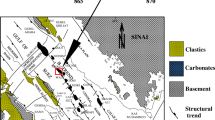Abstract
Spectral gamma-ray measurements were carried out on eight cores collected in the Bransfield Strait at points distributed over a cross section connecting the South Shetland Islands (NW) and the Antarctic Peninsula (SE). These cores were acquired during the cruises OPERANTAR XXXIII, XXXIV, and XXXV, aboard the P/V Almirante Maximiano, from the Brazilian Navy, within the scope of the project “Use of Sedimentary and Biogeochemical Records as Indicative of Climate and Environmental Changes in the South Shetland Islands and Antarctic Peninsula”. The energy spectrum was measured in counts per period through a portable spectrometer which displays the total gamma-ray (total GR) counts, in addition to the individual concentrations of K (%), U (ppm), and Th (ppm), internally converted. The results, integrated with core sedimentological descriptions, enabled us to characterize the different geochemical environments and to recognize paleoenvironmental cycles and stratigraphic surfaces, proving to be a powerful tool for high-resolution stratigraphic studies. The Th/U and U/K ratios reveal six well-marked cycles (identified from A to F) interpreted as transitions from warm to cold periods. The increase in Th/U ratio was used as a proxy for higher clastic meltwater sedimentary input during warm periods, while the increase in U/K ratio indicates higher amounts of organic matter, and therefore higher U content, during cold periods, when clastic sedimentary input is smaller. The concomitant decrease in the Th/U ratio with the increase in the U/K ratio suggests a gradual change from a warm to a cold period. Otherwise, the gradual increase in the Th/U ratio and decrease in the U/K ratio indicates the transition from cold to warm periods. In addition, this study observed different behaviors between proximal and distal gamma-ray spectral logs.








Similar content being viewed by others
References
Anderson JB, Brake C, Domack E, Myers N, Wright R (1983) Development of a polar glacial-marine sedimentation model from Antarctic Quaternary deposits and glaciological information. In: Molnia BF (ed) Glacial-Marine Sedimentation. Plenum Press, New York, pp 233–264
Atkinson A, Peck JM (1988) A summer-winter comparison of zooplankton in the oceanic area around South Georgia. Polar Biology 8:463–473
Bodin S, Fröhlich S, Boutib L, Lahsini S, Redfern J (2011) Early Toarcian source-rock potential in the central high atlas basin (central morocco): regional distribution and depositional model. Journal of Petroleum Geology 34(4):345–363
Davies SJ, Elliott T (1996) Spectral gamma ray characterization of high resolution sequence stratigraphy: examples from Upper Carboniferous fluvio-deltaic systems, County Clare, Ireland. Geological Society, London, Special Publications 104(1):25–35
Fabrés, J.,Calafat, A., Canals, M., Bárcena, M. A., & Flores, J. A. (2000). Bransfield Basin fine-grained sediments: late-Holocene sedimentary processes and Antarctic oceanographic conditions. The Holocene 10.6: 703–718
Fabricius IL, Fazladic LD, Steinholm A, Korsbech U (2003) The use of spectral natural gamma-ray analysis in reservoir evaluation of siliciclastic sediments: a case study from the Middle Jurassic of the Harald Field, Danish Central Graben. Geological Survey of Denmark and Greenland Bulletin 1:349–366
Galindo-Zaldívar J, Gamboa LAP, Maldonado A, Nakaod S, Bochu Y (2004) Tectonic development of the Bransfield Basin and its prolongation, to the South Scotia Ridge, northern Antarctic Peninsula. Marine Geology 206:267–282
García M, Ercilla G, Alonso B, Casas D, Dowdeswell JA (2011) Sediment lithofacies, processes and sedimentary models in the Central Bransfield Basin, Antarctic Peninsula, since the Last Glacial Maximum. Marine Geology 290(1–4):1–16
Gràcia, E.,Canals, M., Farràn, M. L., Prieto, M. J., Sorribas, J. (1996). Morphostructure and evolution of the central and eastern Bransfield basins (NW Antarctic Peninsula). Marine Geophysical Researches 18.2–4: 429–448
Hassan, M.; Hossin, A.; Combaz, A. (1976). Fundamentals of the differential gamma ray log-interpretation technique. SPWLA 17th Annual Logging Symposium. Society of Petrophysicists and Well-Log Analysts
Klaja J, Dudek L (2016) Geological interpretation of spectral gamma ray (SGR) logging in selected boreholes. Nafta-Gaz 72(1):3–14
Magrani FJG, Ayres Neto A (2014) Seismic characteristics and sedimentary distribution on the south Shetland islands continental margin, Antarctica. Revista Brasileira de Geofísica 32(3):549–560
Martins, M. S. (2020) Índices petrofísicos de sedimentos marinhos e suas respostas frente a flutuações climáticas do holoceno tardio, Bacia Central de Bransfield, Antártica. Universidade Federal Fluminense, Master Thesis. 210pp
Prieto MJ, Ercilla G, Canals M, De Batist M (1999) Seismic stratigraphy of the Central Bransfield Basin (NW Antarctic Peninsula): interpretation of deposits and sedimentary processes in a glacio-marine environment. Marine Geology 157(1–2):47–68
Serra, O. Baldwin, J.; Quirein, J. (1980). Theory, interpretation, and practical applications of natural gamma ray spectroscopy. SPWLA 21st annual logging symposium. Society of Petrophysicists and Well-Log Analysts
Tauhata, L., Salati, P. A., Di Prinzio, R., & Di Prinzio, A. R. (2003). Radioproteção e dosimetria: fundamentos (p. 254). CBPF
Wignall PB, Myers KJ (1988) Interpreting benthic oxygen levels in mudrocks: a new approach. Geology 16(5):452–455
Funding
The Ministry of Science Technology and Innovation (MCTI)/Research National Council (CNPq)/National Fund for the Development of Science and Technology (FNDCT), Brazilian Antarctic Program-PROANTAR Call No 64/2013 funded the research project.
Author information
Authors and Affiliations
Corresponding author
Additional information
Publisher’s note
Springer Nature remains neutral with regard to jurisdictional claims in published maps and institutional affiliations.
Rights and permissions
About this article
Cite this article
Nobre, J.A., Freire, A.F.M., Neto, A.A. et al. Quaternary warming and cooling trends in the Bransfield Basin, Antarctic Peninsula, based on gamma-ray spectrometry. Geo-Mar Lett 40, 781–788 (2020). https://doi.org/10.1007/s00367-020-00658-4
Received:
Accepted:
Published:
Issue Date:
DOI: https://doi.org/10.1007/s00367-020-00658-4




